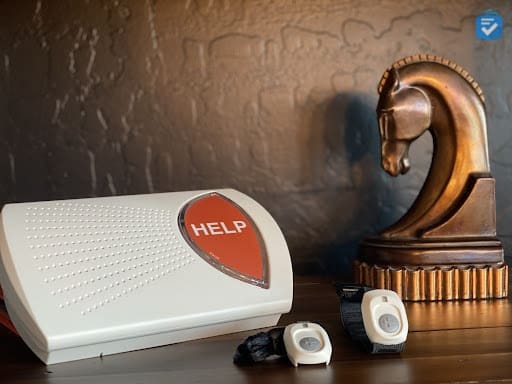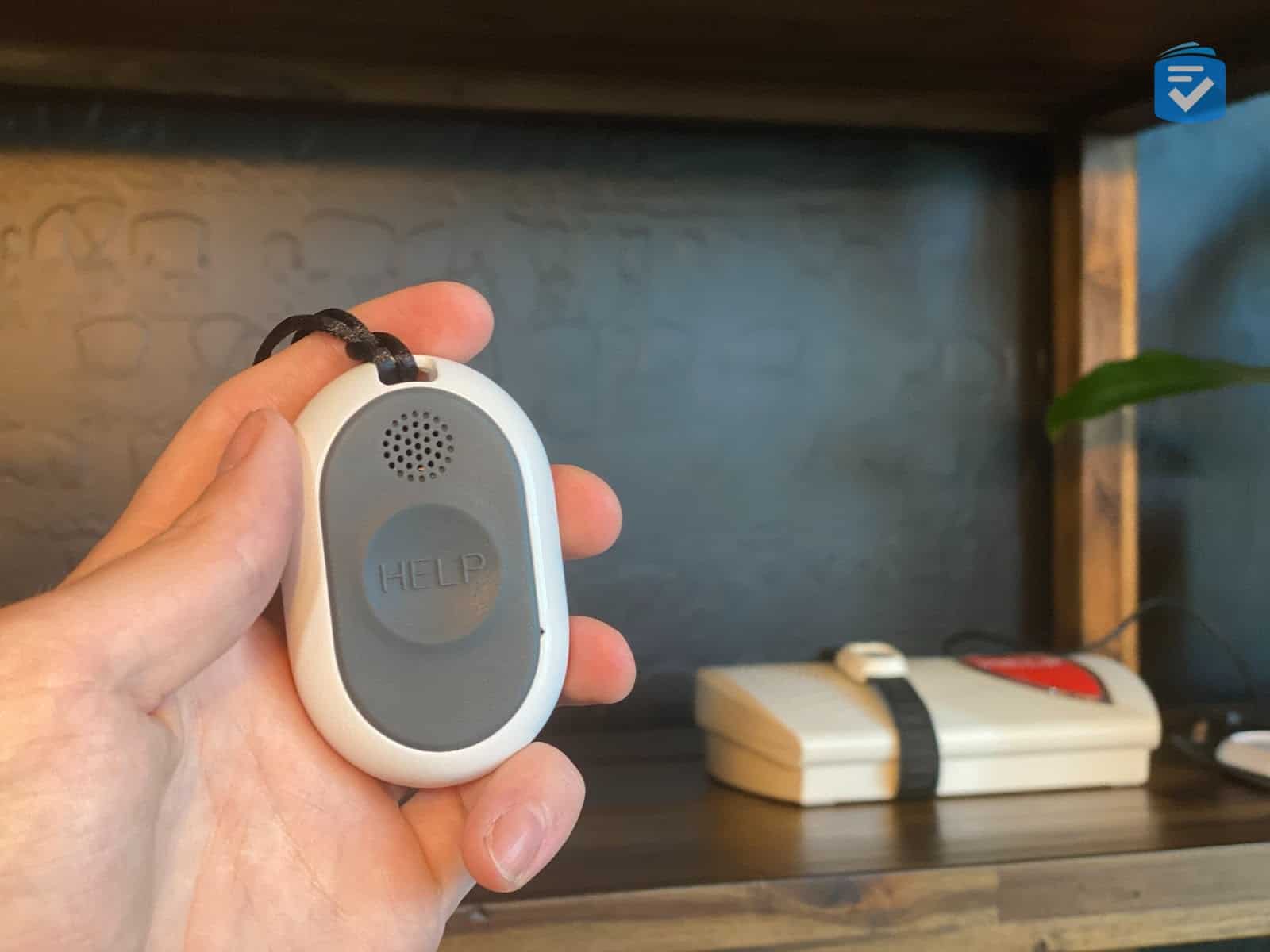The Best Medical Alert Systems for Blind Users, Tested by Caregivers
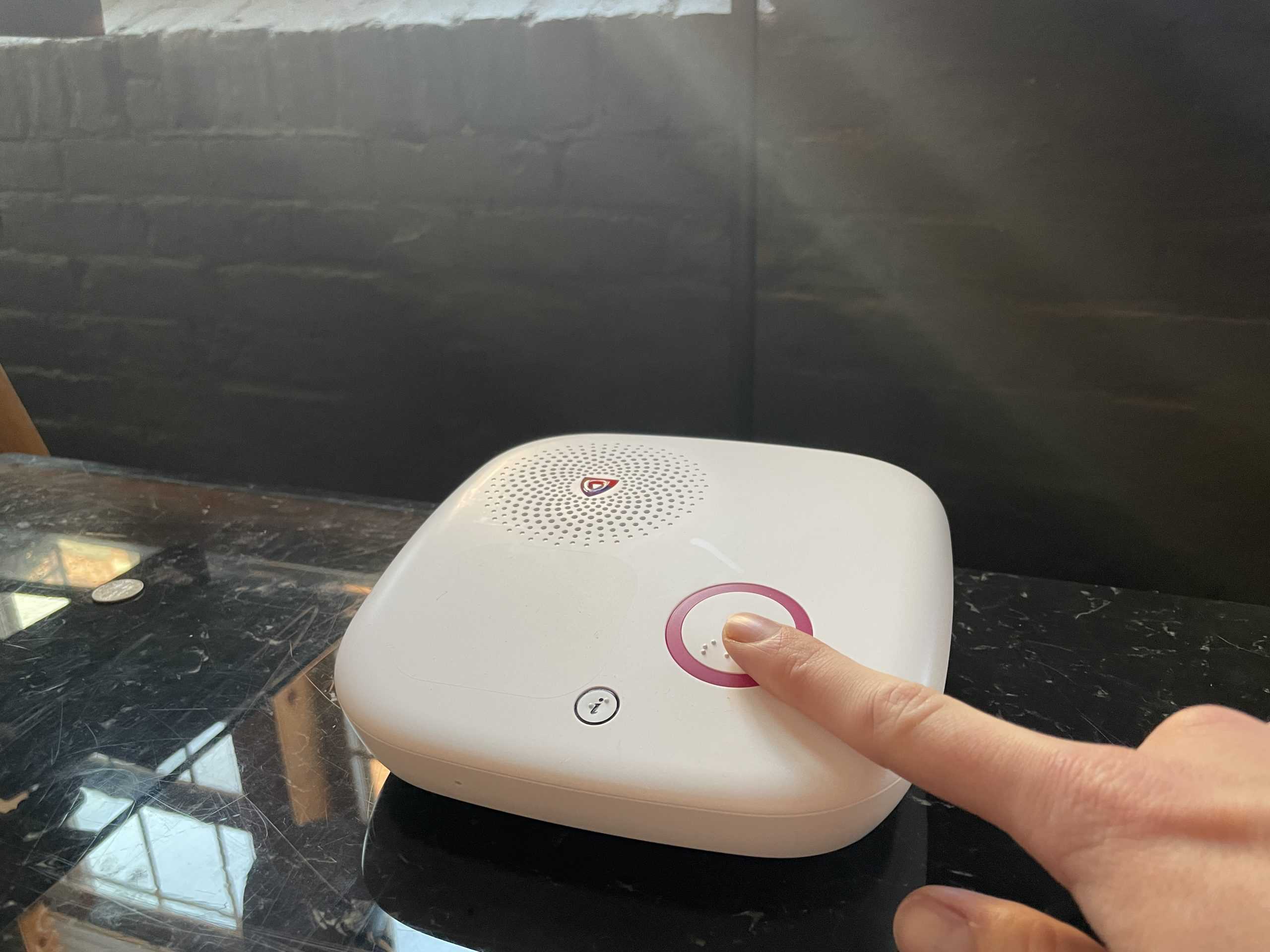
People who have vision loss may find reaching out during a medical emergency more challenging. Luckily, newer emergency-response systems offer features that can make contacting help faster and easier, including voice-activated commands, precise location tracking, and well-designed, intuitive interfaces. These medical alert systems can significantly increase safety and peace of mind for older adults with visual impairments, and at affordable prices.
Because getting help during an emergency as quickly as possible is so important, we’ve conducted extensive tests of emergency-response systems industrywide to determine the products that have the most to offer blind consumers. Here, you’ll find the most durable, reliable and, for older adults on a budget, affordable medical alert products on the market. If you have visual impairments but appreciate living independently, keep reading!
Key Findings
- Medical Guardian performed the best in our tests, answering each of our 10 calls in an average of eight seconds.
- LifeFone’s caregiver app lets loved ones immediately see the wearer’s location, track activity levels and device battery life, and even set a virtual boundary that sends alerts if wearers venture beyond it.
- Bay Alarm Medical offers high-performing systems for $27.95 per month, making them a great affordable option.

Why Trust Us
At TheSeniorList.com, our team of caregivers, experts and health-care professionals conducted over 5,000 hours of in-depth research and testing to recommend the most reliable brands and devices. In this process, our team:
- Tested 50 medical alert devices from 15 different brands.
- Surveyed 1,250 seniors and caregivers about medical alert system usage.
- Consulted with nurses, EMTs, and caregivers who are experts at caring for older adults.
- Published dozens of videos that demonstrate our medical alert system testing.
- Evaluated verified customer reviews of medical alert companies from the Better Business Bureau.
Our Methodology
How We Test Medical Alert Systems
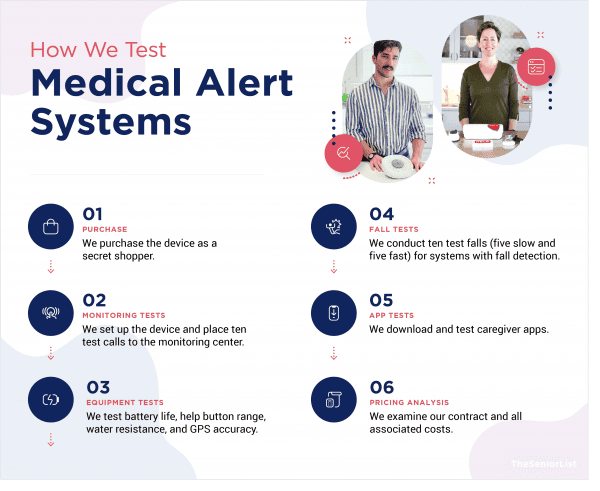
There are no medical alert systems made specifically for blind users, but we evaluated systems on the following criteria:
- Durable equipment: We looked for companies that provided reliable equipment that would perform well in moments of crisis. All of the providers on this list feature water-resistant or waterproof devices that can also withstand falls.
- Activity monitoring: Through motion sensors and accelerometers, medical alert systems can notify loved ones in the event of an extended period of inactivity. This feature is especially useful for loved ones who can’t always be around.
- Location tracking: For more active users who wish to take their system on the go, it’s important that the system has built-in GPS. That way, in the event of an emergency, the system can report a location to first responders.
- Fall detection: A must-have for any medical alert system, fall detection can automatically sense when a user has fallen and contact response agents without the user having to press a button.
- Quick response times: Medical alert systems, in essence, are a direct line of communication to trained response agents. Since every company has their own specific call centers, we make sure to test how quickly they pick up the phone.
Tip: To find other medical alert system options with monitoring starting at $24.99 per month, read our guide to this year’s best medical alert systems.
Our Top Picks
- Medical Guardian : Fastest Response Times
- Bay Alarm Medical : Best Battery Life
- LifeFone : Best Caregiver App
- MobileHelp : Best Budget Option
- UnaliWear Kanega Watch : Best With Fall Detection
1. Medical Guardian - Fastest Response Times

877-947-4512
What We Like Most:
- Tracking of location, battery, system status and connectivity
- Battery life of up to three days
- Step and activity tracking
- Wearable watch design
Overview
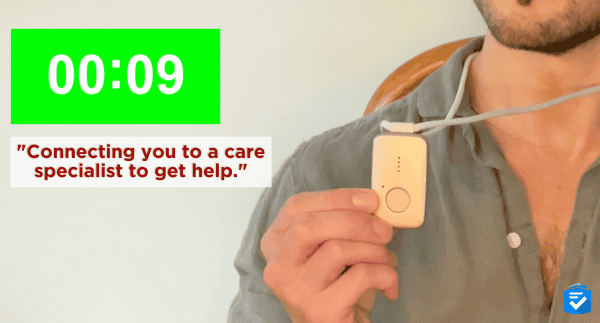
Of all the devices we tested, Medical Guardian had the fastest response times, averaging eight seconds in our test calls. Medical Guardian also offers comprehensive tracking through the MyMedicalGuardian app. That means caregivers and loved ones can see how users are faring with their devices.
Standout Features
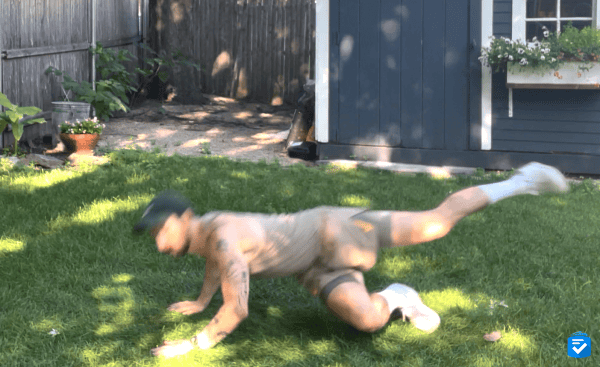
We love the eight-second response time of Medical Guardian, which is one of the fastest we’ve seen in our testing industrywide. But for blind people, we recommend the MGMini Lite, a mobile medical alert with a battery that charges in just three hours and lasts up to three days. Not only does it track the user’s location, but it also tracks their steps and activity levels, allowing for a more comprehensive check-in for caregivers. The MGMini Lite is also water-resistant, with an IP rating of 67. That rating means you can wear it in the shower and the device will remain fully functional.
>> Read More: MGMini Lite Review
Fall detection is not included with the MGMini Lite, but we like that it’s available as an add-on for $10 a month (which is standard across the industry). We wish fall detection was included, as it is with the Kanega Watch. Some systems, such as MobileHelp Duo, require a separate device for fall detection. That’s not the case for the MGMini Lite, however, which has fall detection built into the device. That feature is important for blind users in particular, as they may have trouble finding the button in the event of a fall.
Pricing
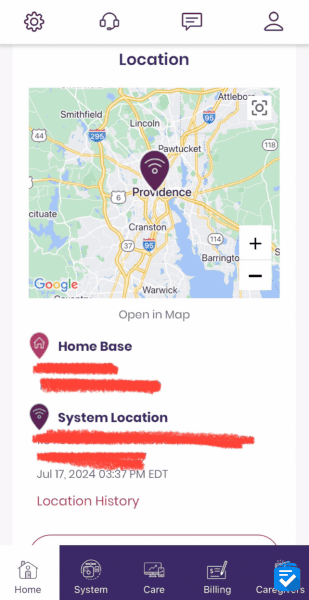
The MGMini Lite costs $149.95, and the monthly fee is $46.95. If you add fall detection, the price goes up to $56.95 per month, which is higher than average for a mobile system.
>> Read More: Medical Guardian Pricing Guide
Drawbacks
The MGMini Lite’s three-day battery life is impressive, but it’s only about half of the battery life of the Kanega Watch. Plus, we wish fall detection was included in the price, as it is with the Kanega Watch.
Our Verdict
The MGMini Lite is an affordable and subtle way to stay safe, no matter where you are. We recommend springing for fall detection, because it could be a lifesaver for a blind user.
To learn more about the company, read our full Medical Guardian review.
Pros
- MyMedicalGuardian app caregiver tracking
- Tracking of activity and steps
- IP67 rating
- Adjustable band
Cons
- Fall detection is $10 per month
- Requires regular charging
2. Bay Alarm Medical - Best Battery Life
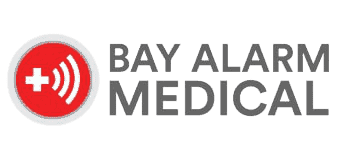
855-675-0754
What We Like Most:
- Six days of power from one charge
- Caregiver tracking through the Bay Alarm Medical app
- Monthly fees start at $27.95
- Optional fall detection
Overview
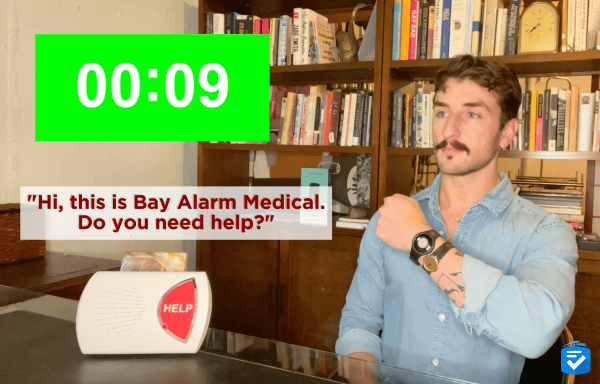
With an average response time of 16 seconds and a battery that lasts up to six days, Bay Alarm Medical devices blew us away.
Standout Features
Bay Alarm Medical offers a variety of straightforward equipment, from a smartwatch to in-home systems, with affordable prices starting at just $27.95 per month for the in-home landline system. We recommend the SOS All-in-One 2, however, which is a medical alert button you can wear everywhere and anywhere.
>> Read More: SOS Smartwatch Review
Wearable on either a belt clip or a neck lanyard, the pendant impressed us with its six-day battery life from a single charge. We wore it all the time, save for the few hours we spent charging it. We even wore it in the shower, since the device has an IP rating of 67, making it water-resistant. As with LifeFone’s VIPx, fall detection is optional with the SOS All-in-One 2 and doesn’t require an additional device. That means a blind user won’t have to search for a button after taking a nasty fall.
Pricing
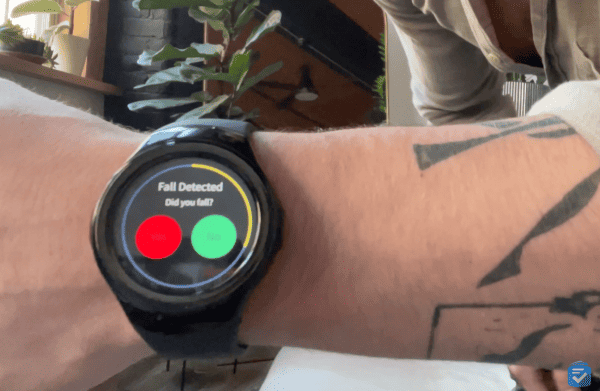
We paid $149 for the SOS All-in-One 2 device. That’s about the same price as the MGMini Lite, but considerably more expensive than the MobileHelp Duo, which comes with a $0 equipment cost. Beyond that, monthly fees range from $34.95 to $54.95, and fall detection costs an extra $10 per month.
The highest-tier package, the SOS All-in-One 2 with the 360° Fall Protection bundle includes an in-home device for even more protection. No matter which package you choose, there are no activation fees. In sum? Bay Alarm offers the lowest monthly prices of any company on this list.
>> Read More: Bay Alarm Medical Costs
Drawbacks
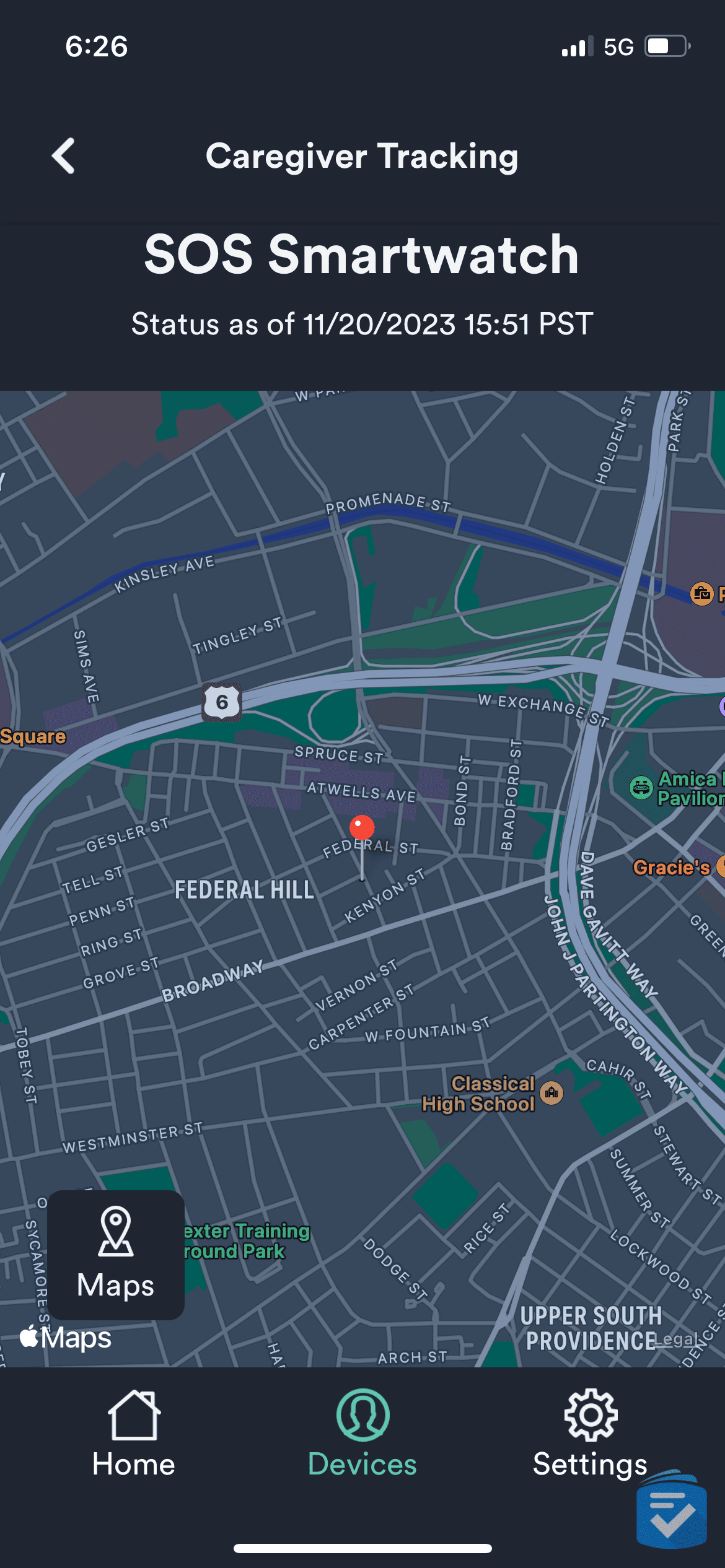
Although we appreciated the caregiver tracking available in the Bay Alarm Medical app, which includes location information and device battery level, the iOS and Android apps were buggy at best. Testing the app on our iPhone, we noticed the GPS tracking was inaccurate and there were no alerts when the device’s battery was low.
Nevertheless, the app’s ratings have recently improved: It was once 2.9 out of 5, but it’s now 4.5 in the Apple App Store and 4.1 in Google Play, where it once had a lowly 1.9 rating.
Our Verdict
The app may not be the friendliest to users, but the SOS All-in-One 2 is both functional and affordable in or outside of the home. To learn more about our experience with this system, read our full Bay Alarm Medical review.
Pros
- Six-day battery life
- Fall detection that doesn’t require another device
- Water-resistant IP rating
- Monthly contracts
Cons
- Pricey equipment fee
- Water-resistant but not waterproof
3. LifeFone - Best Caregiver App

844-996-2846
What We Like Most:
- Battery life up to 10 days
- No equipment or activation fees
- 30-day money-back guarantee
- Highly rated VIPx caregiver app
Overview
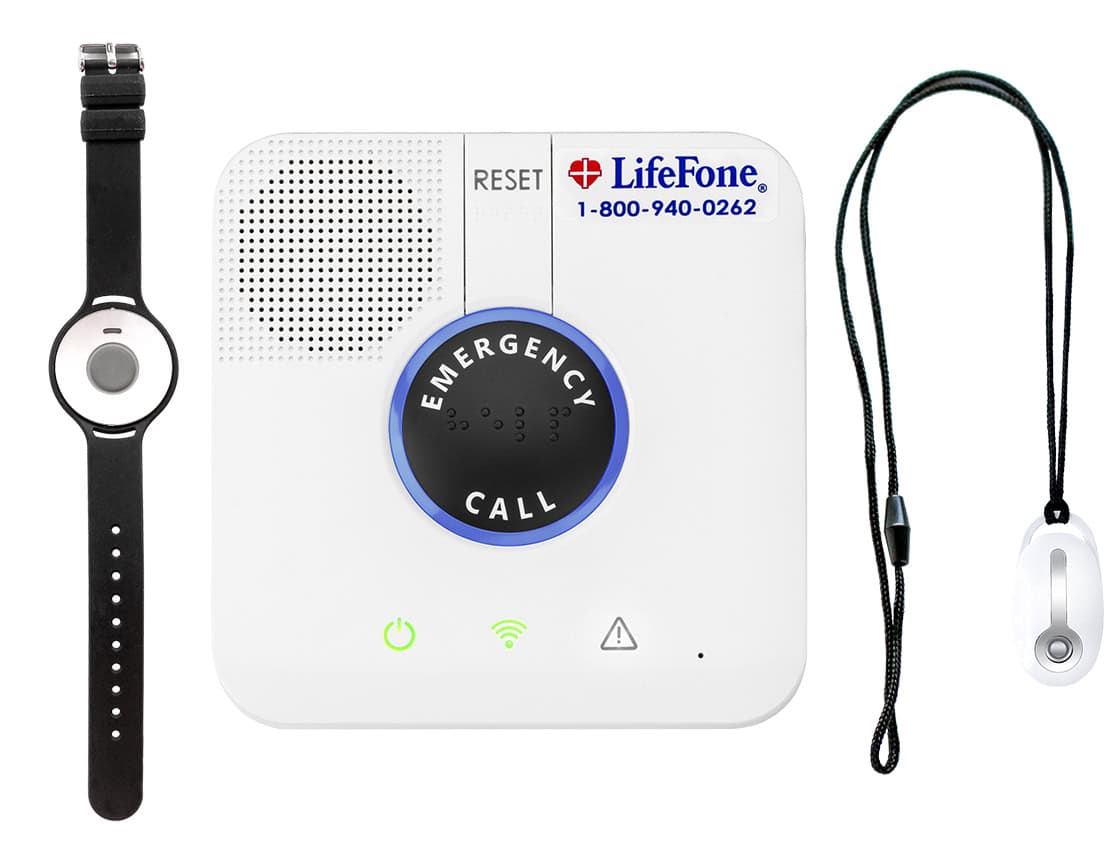
LifeFone offers six medical alert systems with both home and on-the-go devices. You can pay for service by the month, quarter, or year, with monthly costs decreasing with the quarterly and annual options. Quarterly and annual plans include a free month and free shipping, too.
Standout Features
We gave high marks to LifeFone for their excellent customer service, and we were also impressed with the water resistance of the VIPx wearable device. During our tests, we showered with the device and found it still worked perfectly. We also found the VIPx caregiver app to be an excellent resource, despite having to pay $8 a month to use it. Other companies, such as Medical Guardian, offer a caregiver app for free.
Despite the price tag, LifeFone’s app is well-designed and includes several features that can greatly enhance peace of mind for users and their loved ones. With the app, caregivers can check the wearer’s location any time, set and monitor first-motion and daily step goals, and check device battery life. One particularly useful feature is the app’s ability to set up virtual boundaries for wearers: If the wearer ventures outside boundary lines, designated caregivers receive an alert. This feature is enormously helpful for users who have a tendency to wander.
Pricing
We went with the At-Home &On-the-Go VIPx for $43.95 per month. This is on the pricier side compared to many competitors, such as MobileHelp, which has starting prices of $24.95 a month. We added fall detection for another $5 per month, which is half the price that some competitors charge for fall detection, and also paid $8 to use the VIPx caregiver app.
Although these add-ons brought our monthly costs up, we think the peace of mind having both fall detection and a comprehensive caregiver app could be worth the expense for some seniors, particularly those who sometimes wander without letting anyone know where they’re going.
Also keep in mind that LifeFone does not charge equipment or activation fees, which can top $200 with some companies. Aloe Care Health’s Essentials package, for example, costs $199 for the package and an additional $39.99 per month for emergency help and app usage.
Drawbacks
For some reason, LifeFone’s caregiver app is only available with their VIPx device. We would have appreciated using the app with LifeFone’s VIP flex watch or Safe Watch Active. These devices are more modern-looking than the VIPx device, which seniors who prioritize aesthetics and discretion might find unappealing. Still, the VIPx is very easy to use, so older adults with less experience with technology might appreciate its simple design and functionality. It can also be worn clipped to a belt, which can look and feel less obtrusive than wearing it around the neck.
We also found in our tests that LifeFone’s response times are average to below average at about 15 seconds. Although this average aligns with industry standards, it falls short compared with Medical Guardian’s eight-second response average.
Our Verdict
Although LifeFone medical alert systems are not the cheapest on our list, we appreciate their lack of equipment and activation fees, solid GPS location technology, long battery life, and fall-detection accuracy. Another plus is that LifeFone lets you select whether you prefer an AT&T or Verizon cellular connection for your device; this enables users to pick the network with the strongest signal in their area.
To learn more about our experience with these systems, read our full LifeFone Medical Alert review.
Pros
- Devices do not rely on user’s cellular connection
- Monthly contracts
- Water-resistant
- Excellent caregiver app
Cons
- Caregiver app costs extra and is only available with one system
- Above-average monthly costs
- Average emergency response times
4. MobileHelp - Best Budget Option
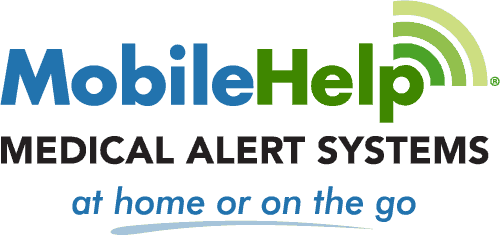
800-915-8738
What We Like Most:
- In-home and out-of-home devices
- Medication reminders
- Activity tracking
- No charge for equipment
Overview
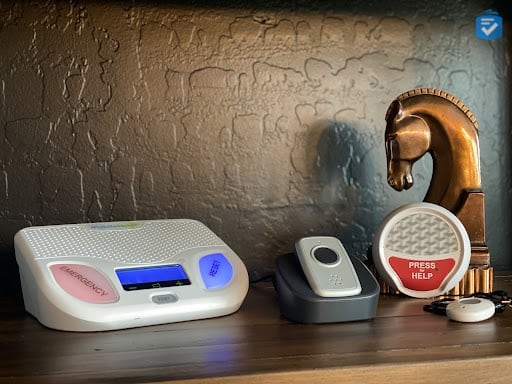
With two at-home systems, two portable systems and two bundles, there’s a lot to choose from when you’re shopping at MobileHelp. Best of all, its systems start at $24.95 per month.
Standout Features
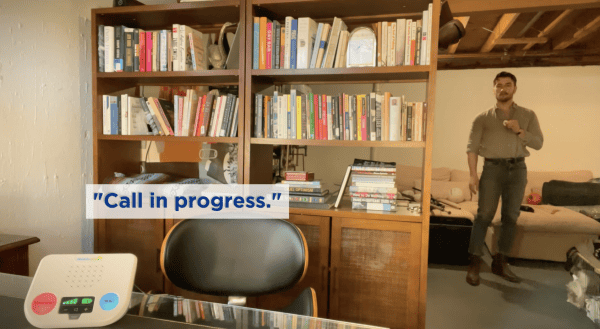
One of the reasons we like MobileHelp is because of the MobileHelp Connect app. Using the app, caregivers can see the device’s location, battery level, system status and how active the user is on a certain day. Caregivers can also set medication reminders and make updates in the app themselves. Medication management is one of many hurdles blind people face, according to the American Foundation for the Blind,1 so having automated reminders can be a huge help.
MobileHelp isn’t short on device and plan options (unlike Kanega, which offers only the Kanega Watch). We recommend the MobileHelp Duo for blind users because the in-home base unit, mobile unit and waterproof help button are all included in the monthly fee. There are no equipment or activation fees, which are standard with many other companies.
Since we saved so much money on equipment, we added a fall detection button for $5.50 per month. It would be nice if fall detection didn’t require a separate device, but considering MobileHelp charges half of what some companies do for monthly fall detection, we weren’t too mad about it.
Pricing
We saved a bundle by not having to pay anything for the MobileHelp equipment. Rather, we paid between $34.95 and $46.95 per month for the monitoring and cellular network that kept us connected to the monitoring center, plus $5.50 more per month for the fall-detection button.
Deal Alert: MobileHelp currently offers one month of service free if you order by calling 800-992-0616.
You can choose to pay monthly, quarterly, semiannually or annually. Typically, monthly fees are lower if you pay for multiple months of service up front, but with MobileHelp, monthly costs are the same no matter which payment plan you choose. There are no activation fees, though, so MobileHelp is still an affordable option.
>> Read More: MobileHelp Pricing Guide
Drawbacks
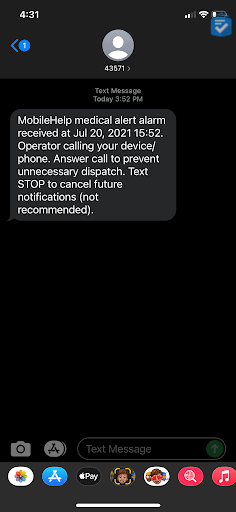
We had a few issues with the Android MobileHelp Connect app, and the iOS app left much to be desired. We found that the app was basically a poorly formatted version of the website, with words cut off and pages cut in half. To access the caregiver tracking, we preferred to use the website, which wasn’t a great experience on a mobile phone.
Our Verdict
For protection at home, outside of the home and even in the shower, MobileHelp offers a variety of options with no equipment fees.
To learn more about our experience with the brand, read our full MobileHelp review.
Pros
- $0 equipment fees
- At home and on-the-go devices
- Activity tracking
- Waterproof help button
- 30-day money-back guarantee
Cons
- Poor iOS app
- On the pricey side for many seniors
- Fall detection costs $5.50 more per month and requires a separate device
5. UnaliWear Kanega Watch - Best With Fall Detection

What We Like Most:
- No equipment fees
- Fall detection included
- Four rechargeable batteries
- Waterproof design

Overview

Many older adults prefer to hide that they’re wearing a medical alert device, and one solution to that problem is a smartwatch. Meet the Kanega Watch from UnaliWear, the company’s sole offering. The Kanega Watch has fall-detection capability built into the device, and it’s included with your monthly subscription.
Standout Features
The Kanega Watch is a durable, waterproof watch we could wear anywhere, including in the shower. We liked that with four rechargeable batteries included, we could just swap the battery out for a new one while the first one was charging. The package also comes with two chargers, ensuring that we never run out of juice.
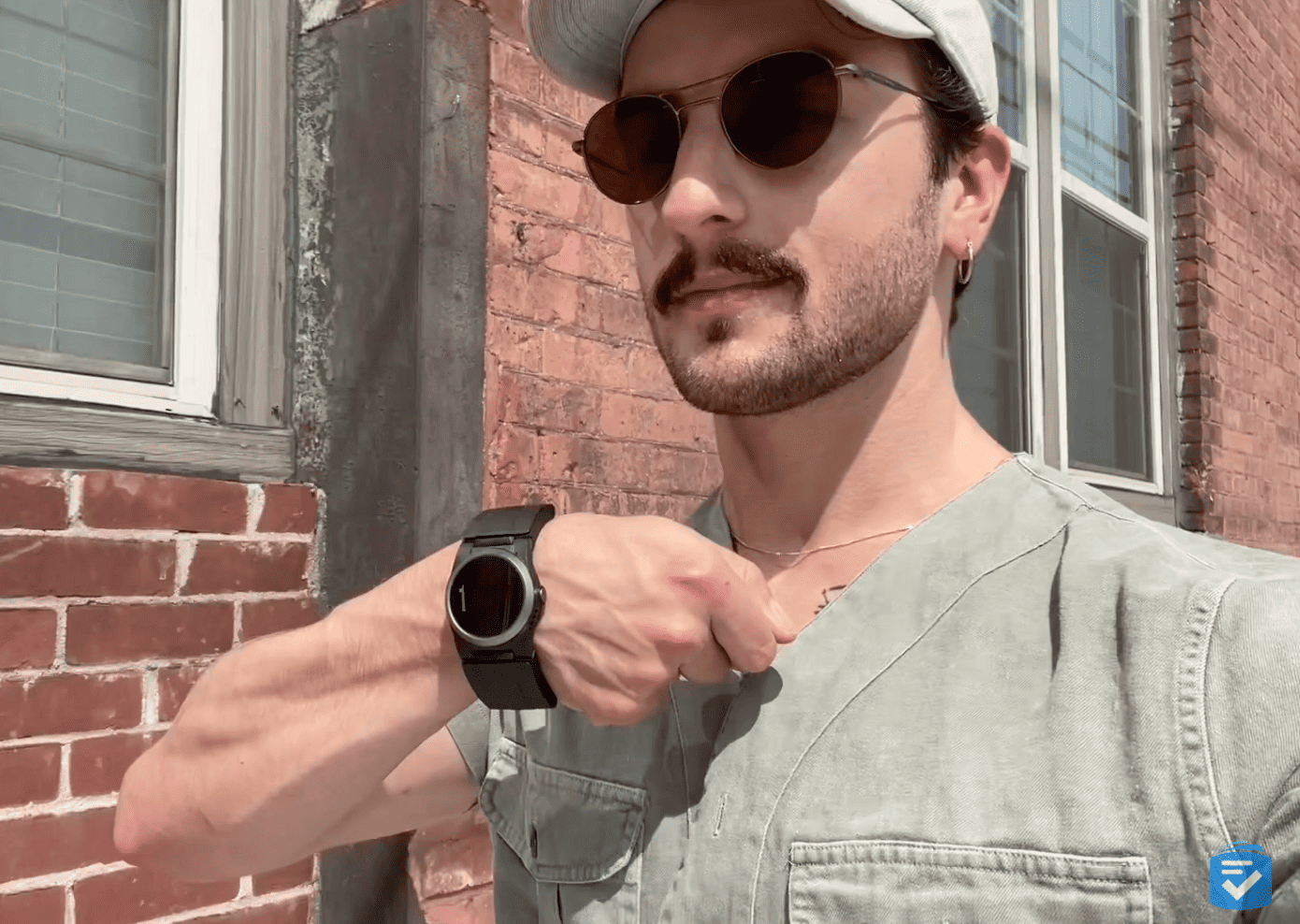
Did You Know: More than 25 percent of adults over 65 experience a fall. Reduce your risk for falls with exercises and other tips from the experts at Johns Hopkins University School of Medicine.2
The lack of additional fees for fall detection makes the Kanega Watch stand out. When we tested the watch by tripping on a sidewalk, the watch asked if we had fallen. Even if we didn’t answer, someone at the monitoring center would have been alerted and dispatched emergency services.
What’s cool about the fall detection on the Kanega Watch is its lack of false alerts. According to UnaliWear, the company collects data from actual falls from all of its watches. The more data it has, the more accurate the patented software is, reducing false alerts. The next time you sit down quickly in a chair, you won’t hear an annoying voice asking if you need help.
Pricing
Like the MobileHelp Duo, the Kanega Watch does not charge equipment fees. But as with some competitors, costs for monitoring over a year are cheaper if you pay annually rather than monthly. An annual subscription costs $779.40, or $64.95 per month, whereas you’ll pay $84.95 per month with a monthly subscription. Those are the highest fees of any device on this list by a pretty wide margin. But there is a silver lining: AARP members and veterans get one month free.
Drawbacks
The main drawback of the Kanega Watch is its substantial cost. We also wish UnaliWear offered more products than just the Kanega Watch, such as a medical alert pendant or an in-home unit. We hope the company will expand its offerings to rival more established companies like Medical Guardian and MobileHelp.
Our Verdict
If you want accurate and reliable fall detection strapped to your wrist at all times, the Kanega Watch is worth the money. To learn more about our experience with the system, read our full Kanega Watch review.
Pros
- Data-driven fall detection included
- Voice activation capability
- Four rechargeable batteries and two chargers
- Waterproof durability
- Free month for veterans and AARP members
Cons
- High activation and monthly fees
- Only one system available
Additional Features to Look for in a Medical Alert System for a Blind User
When shopping for a medical alert system for a blind or visually impaired person, look for the following.
Large Buttons
Check the base unit on the system you’re considering. Most medical alert systems worth their salt have large buttons for easy use. Textured buttons and bright colors can also help those with limited eyesight.
If in doubt, we recommend calling the medical alert company and asking some questions. Any good medical alert service agent will be delighted to help, and you’ll get a taste of the company’s customer service too.
Think carefully about wearable buttons. The wearable button is vital because it ensures that you can summon help even when you’re not near the base station. Make sure the button is large enough to find and press easily and that it’s comfortable enough to wear all the time.
Caregiver Tracking
The best medical alert systems let caregivers track their loved ones through either a web portal or a mobile application available for iPhones and Android devices. The LifeFone VIPx caregiver app is an excellent example of allowing us to track the whereabouts of a wearer’s location from our phone.
Voice Commands
Voice-command options are ideal for people who would rather not wear a medical alert device 24/7. Some, but not all, of the devices we reviewed offer this feature.
FYI: Seniors more comfortable with technology and open to discovering its benefits are more likely to wear fall-detection devices, highlighting the importance of education about medical alert device capabilities, according to a study published in JMIR Aging.3
Medical Guardian offers an optional voice-activated wall button that enables users to call for help if they can’t reach the button. Bay Alarm Medical’s SOS Smartwatch has two-way talk capability, although users must press the button to contact help agents; it can’t be done via voice alone.
The Kanega Watch is the only mobile device on our list of best systems for blind users that offers a voice-command help option. That makes the watch an excellent, safety-enhancing choice for people with visual impairments, as long as they can afford the substantial monthly fees.

Integrated Fall Detection
Medical alert systems with fall detection are a great tool to keep people safe. Fall detection isn’t perfect and false alarms happen, but we still recommend it since it helps more often than it hinders and medical alert providers are used to the occasional false alarm.
Visually impaired seniors may have trouble distinguishing between their medical alert device and fall-detection pendant, which could lead to a delay in pressing the button to get help. That can pose a problem for older adults who are visually impaired, because with some companies, fall detection comes as a separate pendant that must be worn along with the alert button. That is why we recommend that older adults who are visually impaired look for an integrated fall-detection option, such as LifeFone’s VIPx or the Lively Mobile Plus.
All-in-One Mobile Units
Medical alerts with GPS work outside the home using a cellular network. They’re ideal for older adults who still live active lifestyles but who would like some added protection throughout their day. Some GPS alerts feature the mobile device itself, plus a separate button to wear to summon help. The user and operator then talk via the two-way speaker in the mobile device.
With two-way voice-integrated pendants, everything is in one unit. In the event of an emergency, you simply press your button to talk to the call center via the same device.
GPS voice-in-pendants are ideal for visually impaired seniors no matter what their activity level. The two-way speaker function means you can carry it with you wherever you go in the home or garden. That can offer older adults great peace of mind in knowing they can always talk to someone without the need to be in the range of a base station.
Month-to-Month Contracts
Most medical alert companies don’t require you to purchase their equipment. Rather, the equipment is leased through your monthly service agreement. We always recommend medical alert companies that don’t lock you into a long-term contract.
Alternatively, you could consider an unmonitored medical alert system.
Bottom Line
Vision loss and blindness become more widespread with age. By ages 75 to 79, 8 percent of U.S. adults will have experienced vision loss, and that number goes up to 21 percent for those 85 and older, according to a study published in JAMA Ophthalmology.4 For blindness, those numbers are 1 percent and 6 percent, respectively. Medical alert systems with accessibility features are a great way to help blind people stay safe while remaining independent.
Frequently Asked Questions
-
Are there medical alert systems designed specifically for blind users?
Although there are no medical alert systems designed exclusively for blind users, many medical alert systems offer designs and features that can greatly increase a sense of safety and peace of mind among people with visual impairments.
-
What should blind seniors look for in a medical alert system?
Helpful features for blind and visually impaired older adults include medical alert systems that allow voice-activated calls for help; large, easy-to-distinguish buttons; precise location tracking; and caregiver monitoring capability.
-
Do Medicare or Medicaid cover the cost of medical alert systems?
Medicare Part A will not cover the cost of a medical alert system, but some states may provide assistance via Medicaid Home and Community Based Services (HCBS) waivers.
-
Does AARP offer discounts on medical alert systems?
Yes, AARP sometimes offers discounts on medical alert systems. Check their website for current offers. UnaliWear, one of the companies we reviewed here, also currently offers one month of service free to AARP members.
-
Do most medical alert systems require long-term contracts?
No, many medical alert systems can be paid for on a month-to-month basis with no long-term commitment.


